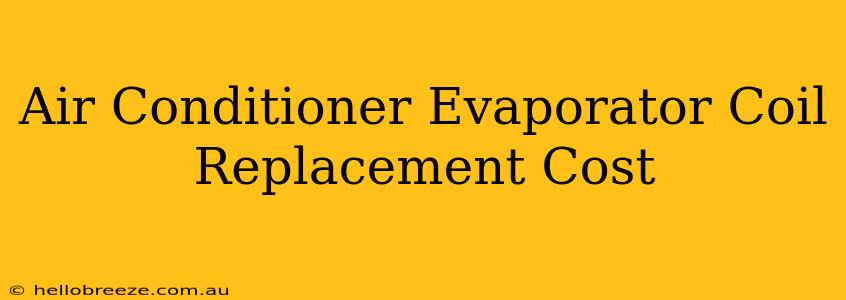Replacing your air conditioner's evaporator coil is a significant investment, but understanding the costs involved can help you budget effectively. This guide breaks down the factors influencing the price of evaporator coil replacement, providing you with a clearer picture of what to expect.
Understanding the Evaporator Coil
Before diving into costs, let's clarify what an evaporator coil is and why it's crucial. The evaporator coil is a vital component of your AC system. It's responsible for absorbing heat from the air inside your home, cooling it down. Over time, this coil can become dirty, corroded, or even leak refrigerant, reducing efficiency and potentially leading to complete system failure. Therefore, replacement is sometimes necessary to maintain optimal cooling and prevent costly repairs later.
Factors Affecting Evaporator Coil Replacement Cost
Several factors influence the total cost of replacing your air conditioner's evaporator coil:
1. The Size and Type of Your AC System:
The size of your AC unit directly impacts the size and cost of the evaporator coil. Larger systems naturally require larger, more expensive coils. The type of system – central air, mini-split, or window unit – also plays a role. Central air systems generally involve more complex installations and higher replacement costs.
2. The Brand and Model of Your AC Unit:
Replacement coils are often brand-specific, meaning you'll likely need a coil designed for your particular AC unit's make and model. Some brands command higher prices than others. Obtaining a genuine OEM (Original Equipment Manufacturer) part might be more expensive but is often the best option for ensuring compatibility and long-term performance.
3. Labor Costs:
Labor charges represent a significant portion of the overall cost. The complexity of accessing and replacing the evaporator coil (depending on your system's location and accessibility) will influence the labor hours required, which directly impacts pricing. Consider obtaining multiple quotes from reputable HVAC technicians to compare labor costs.
4. Refrigerant and Other Materials:
During the replacement process, the system might require additional refrigerant. The cost of refrigerant varies depending on market fluctuations and the amount required. Other incidental materials, such as sealant or other necessary parts, could also add to the total cost.
5. Location and Technician Expertise:
Geographic location significantly impacts labor costs. Areas with higher labor costs will naturally reflect higher overall prices. Furthermore, hiring a highly experienced and skilled technician might cost more but could lead to a more efficient and accurate installation.
Cost Estimates
While providing a precise price is impossible without a detailed assessment of your specific system, here's a general range:
- Low End: $500 - $1000 (This might apply to simpler systems and less extensive labor requirements.)
- Mid-Range: $1000 - $2000 (This represents a common price range for many standard systems.)
- High End: $2000+ (More complex systems, specialized parts, or unforeseen complications could lead to higher costs.)
It's strongly recommended to contact multiple HVAC professionals for in-home evaluations and detailed quotes before making a decision. This allows you to compare pricing, services, and warranties.
Preventative Maintenance: Extending Coil Lifespan
Regular maintenance is key to extending the lifespan of your evaporator coil and preventing premature replacement. This includes:
- Annual AC Tune-Ups: Professional inspections and cleaning can identify potential issues early, reducing the risk of major repairs.
- Regular Air Filter Changes: A clogged air filter restricts airflow, forcing the system to work harder and potentially damaging the coil.
- Keeping the Unit Clean: Remove debris and obstructions around your outdoor unit to ensure proper airflow.
By understanding the factors influencing the cost of evaporator coil replacement and proactively maintaining your system, you can significantly extend its lifespan and potentially save money in the long run. Remember, investing in a properly functioning AC system ensures comfort and efficiency for years to come.

